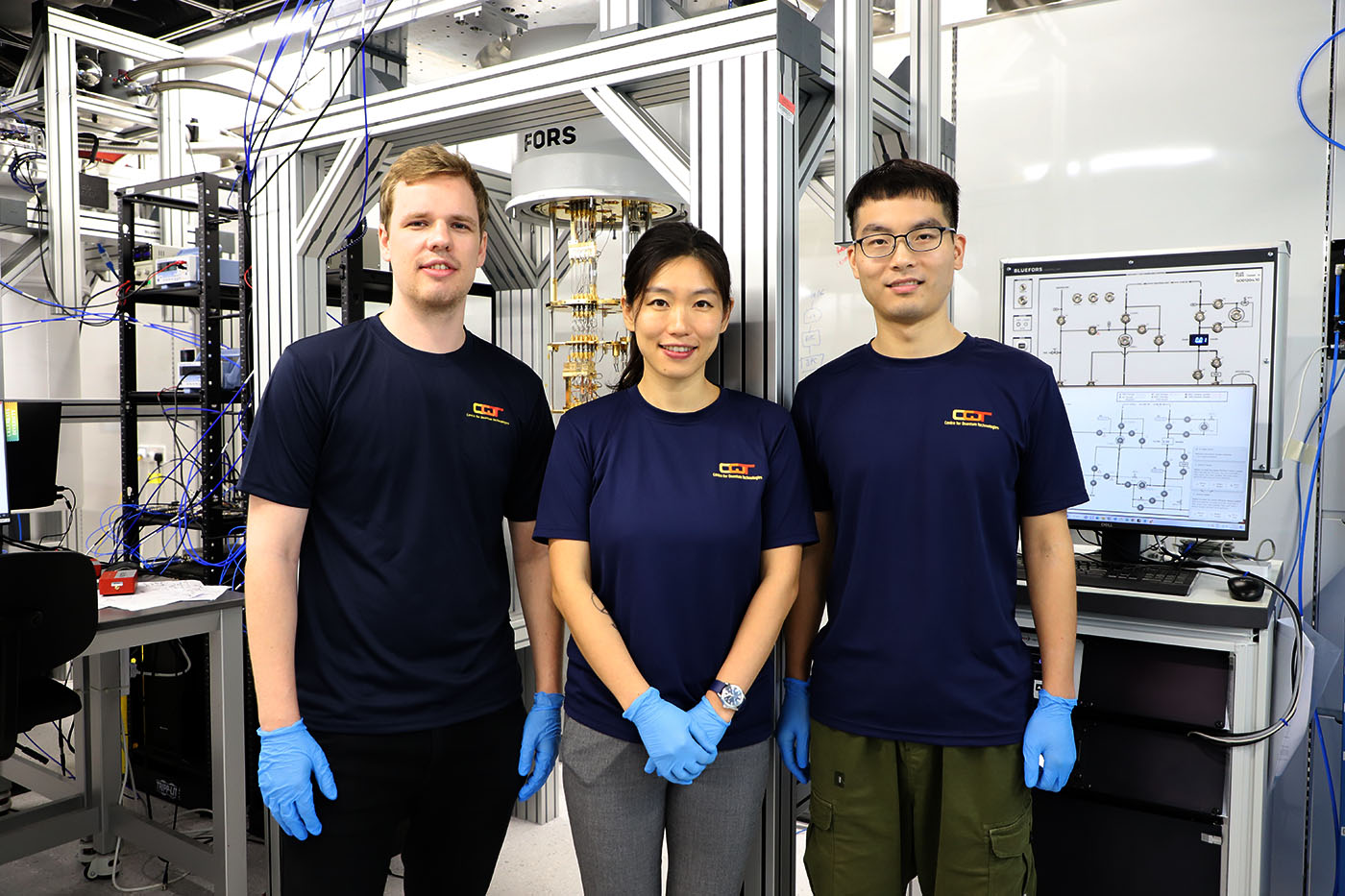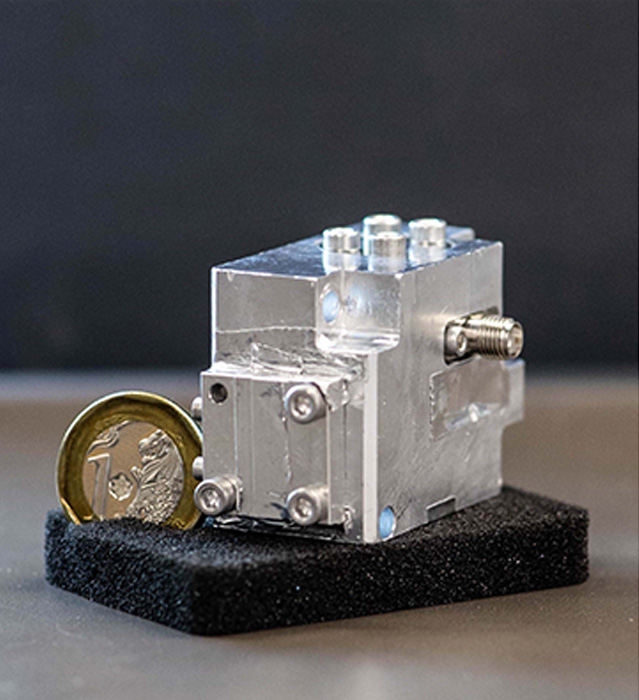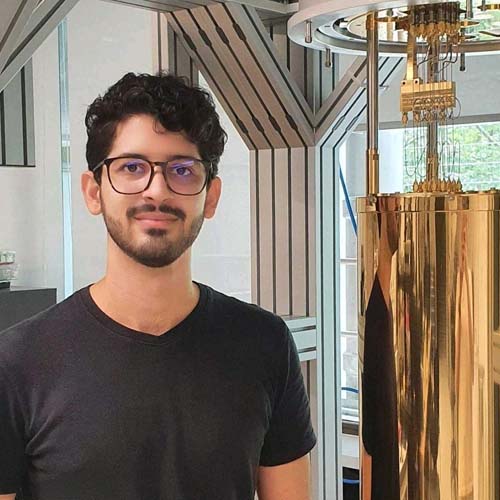Highlights
Quantum cats get squished for their own protection
 (From left) Congratulations to CQT PhD student Jonathan Schwinger, Principal Investigator Yvonne Gao, Research Fellow Pan Xiaozhou and their team! The group has published their first experimental paper showing how compressed cat states keep their quantum features longer.
(From left) Congratulations to CQT PhD student Jonathan Schwinger, Principal Investigator Yvonne Gao, Research Fellow Pan Xiaozhou and their team! The group has published their first experimental paper showing how compressed cat states keep their quantum features longer.
Experiments at CQT have shown a way to prolong the life of a quantum cat. The work by the group of Principal Investigator Yvonne Gao and collaborators, reported in Physical Review X on 7 April 2023, could bolster prospects to build quantum computers by encoding quantum information in cat states.
Named after Schrödinger’s famous hypothetical cat that is simultaneously dead and alive, a cat state is a superposition of quantum states with opposite phases. Research suggests that qubits encoded in cat states could be resistant to certain types of errors arising from hardware imperfections that could derail computations. There has been remarkable progress, across academic and industrial research groups, in engineering cat qubits due to their scientific and technological appeal.
The CQT team tackles a second problem faced in building quantum computers: maintaining the delicate quantum properties of qubits for long enough to correct errors and complete a task. Computing with cat states uses interference features resulting from their superposition, which can be lost to decoherence. The team’s solution? They compress the cat.
“Our technique to compress the phase-space of cat states could help give cat states a longer qubit lifetime,” says CQT Research Fellow Xiaozhou Pan, who is the joint first author of the work together with PhD student Jonathan Schwinger. Xiaozhou, Jonathan and Yvonne’s co-authors are group members Huang Ni-Ni, Song Pengtao, Chua Weipin, Atharv Joshi, Fernando Valadares, and collaborators Fumiya Hanamura and Radim Filip.
Yvonne, who is also a Presidential Young Professor in the NUS Department of Physics, joined CQT in 2020. She has since grown her group to a team of more than ten people running experiments in two dilution refrigerators, nicknamed Merlin and Iara. This is the group’s first experimental result.
Compressed cats
The group generates cat states inside a cavity machined from high-purity aluminium, which is made superconducting by cooling it to below 15 mK in one of the lab’s fridges. The cavity acts as a quantum harmonic oscillator, a high dimensional system that can store quantum information. Some electrical components inside the cavity create and manipulate the quantum states. This assembly is more technically known as a three-dimensional circuit quantum electrodynamics architecture.
 The group’s device consists of a superconducting cavity, an ancillary transmon and a planar readout resonator. The cavity (pictured) is machined out of high-purity aluminium and is just taller than a Singapore $1 coin.
The group’s device consists of a superconducting cavity, an ancillary transmon and a planar readout resonator. The cavity (pictured) is machined out of high-purity aluminium and is just taller than a Singapore $1 coin.
Cat states in the cavity decohere mainly because of photon loss. Like any quantum state, cat states can be represented by a phase-space distribution. The researchers found that by manipulating the phase-space distribution – compressing it – they protect the quantum interference features essential to making the cat state useful from the impact of photon loss.
In their scheme, the researchers achieve the compression by repeatedly applying echoed conditional displacement (ECD) gates.
They generated cat states with phase-space compression of -3 dB when the ECD gate was applied once, -6.7 dB when the gate was applied twice, and -7.6 dB when the gate was applied thrice. The compression reshapes the quantum state’s distribution and generates a more compact cat.
Better protection
“How much compression to apply depends on what you want to protect,” says Jonathan. The researchers measured and visualised their cat states using a characteristic function, a type of phase-space distribution plotted in two dimensions. The quantum interference features show up as blobs away from the origin. In the phase-space compression, they are brought closer to the origin. This inner zone – corresponding to lower frequency components – is less affected by photon loss.
In these plots, the team could see that the interference features were longer-lived in the compressed cat states. For example, the quantum interference features were still prominent at 100 microseconds in compressed cat states with -6.7 dB of compression, while they had vanished by this time from uncompressed cat states.
After this first step improving the quality of their cat states, the researchers plan to further pursue its potential in quantum metrology to enhance measurement accuracy. They also plan for a multi-cavity setup to generate more cats at the same time.
Learn more
Related Stories
National science award for CQT’s Yvonne Gao December 10 2021 | |
 | Meet a CQTian: Fernando Valadares April 11 2022 |
 | CQT welcomes three new Principal Investigators: Meet Yvonne Gao May 20 2020 |






